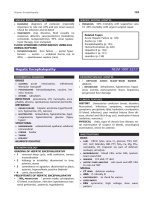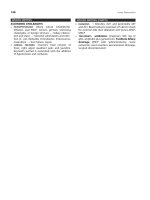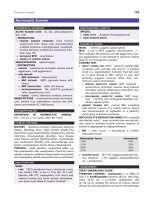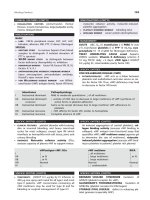Approach to internal medicine phần 2
Bạn đang xem bản rút gọn của tài liệu. Xem và tải ngay bản đầy đủ của tài liệu tại đây (59.36 KB, 5 trang )
To Ella and Rupert
David Hui
Disclaimer
Approach to Internal Medicine is meant to be a practical field guide.
Dosages of medications are provided for quick reference only. Readers
should consult other resources before applying information in this
manual for direct patient care. The author, editors, and publisher of
Approach to Internal Medicine cannot be held responsible for any harm,
direct or indirect, caused as a result of application of information con
tained within this manual.
vii
Preface
Practice is science touched with emotion.
Confessio Medici, Stephen Paget, 1909
The third edition of Approach to Internal Medicine builds upon previous efforts to create a practical,
evidence based, and concise educational resource for everyday clinical use and examination preparation.
Approach to Internal Medicine now has an expanded repertoire of over 250 internal medicine topics,
classified under 17 subspecialties. With the input of a new editor and publisher, we were able to
significantly expand and update the content and substantially improve the layout, while maintaining
the same conciseness and practicality found in previous editions.
Under each topic, the sections on differential diagnoses, investigations, and treatments are designed
for the rapid retrieval of high yield clinical information and can be particularly useful when one is all alone
assessing a patient at 3 o’clock in the morning. Other sections contain many clinical pearls that are intended
to help one to excel in patient care. We also included many comparison tables aimed at highlighting the
distinguishing features between various clinical entities and numerous mnemonics (marked by w). In
addition to everyday practice, Approach to Internal Medicine can be effectively used as an examination study
guide and teaching script.
For this new edition, we are very fortunate to have recruited a new associate editor, Dr. Alexander
Leung, who brings with him a wealth of knowledge and outstanding commitment to medical education.
We are most grateful to our section editors and contributors for their meticulous review of each
subspecialty, providing expert input on the most up to date information. We would also like to take
this opportunity to thank Jean Claude Quintal as a resident reviewer and the Canadian Federation of
Medical Students for its support of the previous edition. Finally, we would like to thank all previous and
current users of this manual for their support and feedback.
We are pleased that Springer has taken this title under its direction and has helped to improve its
quality in preparation for international release. In addition to International System (SI) units, this edition
also provides US customary units [in square brackets] for quick reference. We would particularly like to
thank Laura Walsh, senior editor, and Stacy Lazar, editorial assistant, from Springer for their expert
guidance and support throughout this mammoth project from design to production. We would also like
to thank Walter Pagel, director of scientific publishing at M.D. Anderson Cancer Center, for believing in
this work and making this collaboration possible.
While every effort has been made to ensure the accuracy of information in this manual, the author,
editors, and publisher are not responsible for omissions, errors, or any consequences that result from
application of the information contained herein. Verification of the information in this manual remains
the professional responsibility of the practitioner. Readers are strongly urged to consult other appro
priate clinical resources prior to applying information in this manual for direct patient care. This is
ix









